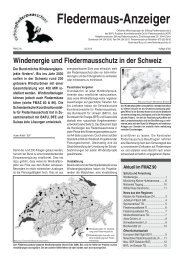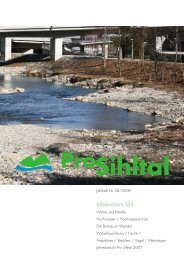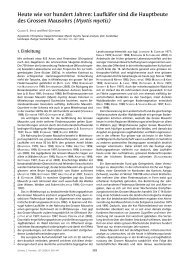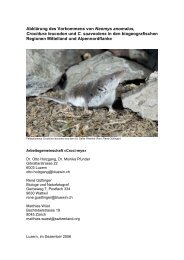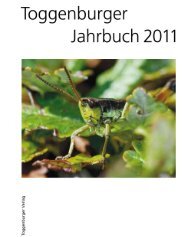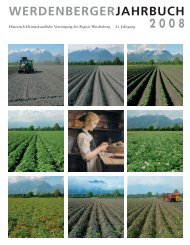Layout 1 - Landesverwaltung Liechtenstein
Layout 1 - Landesverwaltung Liechtenstein
Layout 1 - Landesverwaltung Liechtenstein
Sie wollen auch ein ePaper? Erhöhen Sie die Reichweite Ihrer Titel.
YUMPU macht aus Druck-PDFs automatisch weboptimierte ePaper, die Google liebt.
Inhalt<br />
Abstract 7<br />
Zusammenfassung 8<br />
1 Zielsetzung des Projektes 8<br />
2 Der Naturraum <strong>Liechtenstein</strong>s 9<br />
2.1 Vielfalt auf kleinstem Raum 9<br />
2.2 An der Grenze von West- und Ostalpen 10<br />
2.3 Klimatisch begünstigt 10<br />
2.4 Lebensräume in <strong>Liechtenstein</strong> 11<br />
3. Jagd und jagdbare Säugetierarten 14<br />
3.1 Gesetzliche Grundlagen 14<br />
3.2 Waldgerechter Wildbestand und wildgerechter Wald 14<br />
3.3 Die Grenzen der Jagd und des Jägers 15<br />
3.4 Warum jagen? 15<br />
4. Datenquellen 16<br />
4.1 Zur Geschichte der säugetierkundlichen Erforschung<br />
<strong>Liechtenstein</strong>s 16<br />
4.2 Methodisches Vorgehen 18<br />
5. Systematik 21<br />
6 Artbeschriebe 23<br />
6.1 Ordnung Insektenfresser 24<br />
6.2 Ordnung Fledermäuse 48<br />
6.3 Ordnung Nagetiere 94<br />
6.4 Ordnung Hasenartige 134<br />
6.5 Ordnung Raubtiere 140<br />
6.6 Ordnung Paarhufer 164<br />
6.7. Eingewanderte Arten 181<br />
7 Prioritäten des Schutzes heimischer Säugetiere:<br />
Empfehlungen und Massnahmen 186<br />
7.1 Rote Listen 186<br />
7.2 FFH-Berichte 187<br />
7.3 Verantwortlichkeit 188<br />
7.4 Folgerungen für den Säugetierschutz 188<br />
7.5 Forschungslücken und Monitoring 188<br />
7.6 Allgemeine Biotopmassnahmen für den<br />
Säugetierschutz 190<br />
7.7 Artenhilfsprogramme 192<br />
7.8 Öffentlichkeitsarbeit 192<br />
7.9 Fördermassnahmen - Übersicht 192<br />
8 Dank 193<br />
9 Literatur<br />
9.1 Allgemeine Literatur 194<br />
9.2 Spezielle Literatur 194<br />
10 Index Arten 198<br />
10.1 Deutsch 198<br />
10.2 Wissenschaftlich 199<br />
11 Anschrift der Autoren 200<br />
Abstract<br />
<strong>Liechtenstein</strong> is a topographically diverse country despite its<br />
small size of just 160 km 2 , home to a rich mammalian fauna<br />
and high habitat heterogeneity. This monograph is the first<br />
comprehensive overview of the mammals of <strong>Liechtenstein</strong><br />
since Ernst von Lehmann’s «Säugetieren des Fürstentums<br />
<strong>Liechtenstein</strong>», published in 1962. Extensive bat distribution<br />
data from decades of research by Silvio Hoch, as well as data<br />
from a recent three-year small mammal distribution study<br />
are the foundation of this compendium. Data from the<br />
«Amt für Wald, Natur und Landschaft» and observations by<br />
the general public complement these studies.<br />
76 species are portrayed in detail with a majority also<br />
featuring <strong>Liechtenstein</strong> distribution maps. Information on<br />
distribution, habitat preferences, threats and possible conservation<br />
measures make this monograph an invaluable<br />
resource for conservation work, as many species are internationally<br />
protected and endangered in neighboring countries.<br />
Several bat species, but also the charismatic beaver are<br />
prime examples. Creating red list of endangered species of<br />
<strong>Liechtenstein</strong> was not attempted as data is still incomplete<br />
for a number of species.<br />
The aforementioned studies revealed significant need to improve<br />
our knowledge of distribution and habitat use of bats,<br />
small mammals and martens. Additionally, population monitoring<br />
of hare, beaver, and non-native fauna should be conducted<br />
regularly.<br />
Conserving mammalian diversity in <strong>Liechtenstein</strong> must also<br />
include habitat conservation and restoration. Particularly<br />
important are the restoration of watercourses, increasing<br />
habitat heterogeneity on agricultural lands, decreasing<br />
farming intensity, conserving old growth forest patches, and<br />
creating wildlife sanctuaries. Urban areas could present suitable<br />
habitat for a variety of bat species if bat roosts on<br />
buildings are conserved and encouraged. Lastly, the large<br />
carnivores, wolf, bear and lynx would benefit primarily from<br />
an educated, tolerant public attitude.<br />
Keywords: mammals, <strong>Liechtenstein</strong><br />
7



